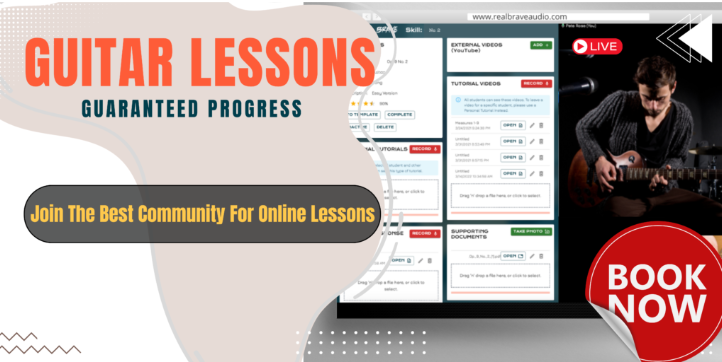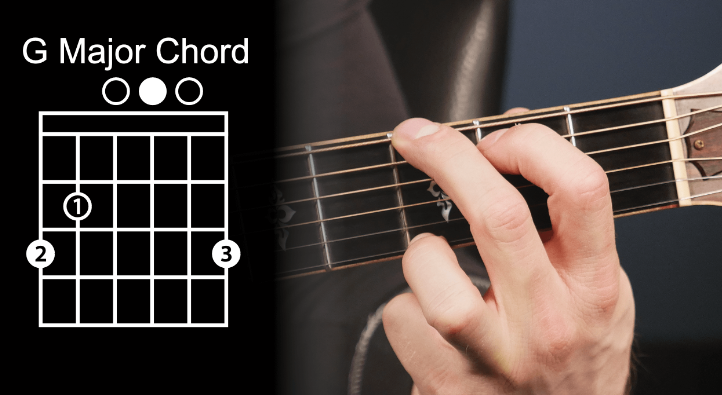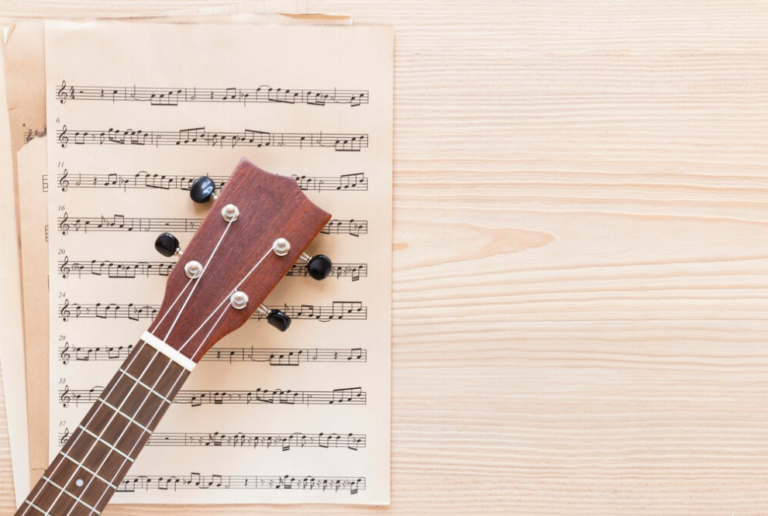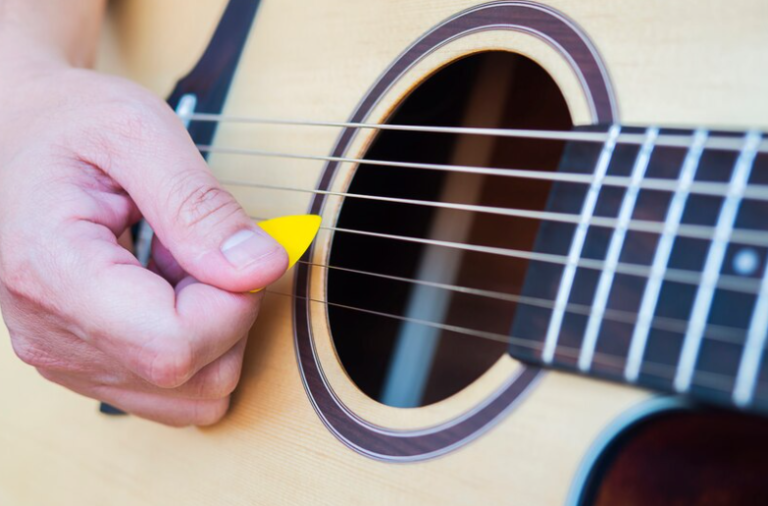A Flat Major Scale – Everything You Need To Know About How To Play it – Easy Guide
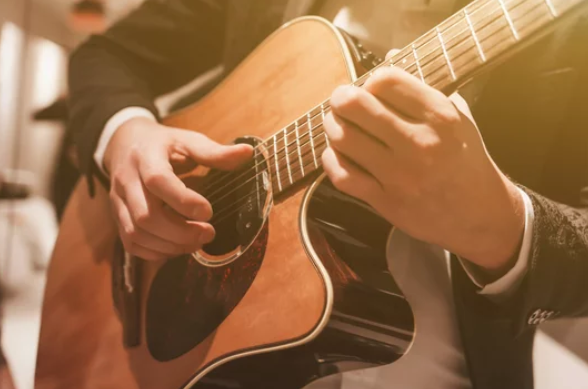
The A Flat Major Scale on the guitar is great for learning. It involves a specific pattern of whole and half steps across the fretboard and might require finger stretching, especially if you’re playing it in lower positions.
Notes Of The A Flat Major Scale
The A-flat Major scale contains the following notes:
Ab – Bb – C – Db – Eb – F – G
How To Play It?
- Find the Starting Note: Locate the A♭ note on your guitar. The A♭ note can be found on the 4th fret of the low E string (6th string), or the 11th fret of the A string (5th string). You can start from either position, but for beginners, starting from the 4th fret of the low E string might be easier.
- Play the Scale: From the starting A♭ note, the basic pattern to play the A Flat Major Scale in the first position (starting on the 4th fret of the low E string) is as follows:
- 6th String (E string): Play A♭ (4th fret), B♭ (6th fret)
- 5th String (A string): Play C (3rd fret), D♭ (4th fret), E♭ (6th fret)
- 4th String (D string): Play F (3rd fret), G (5th fret)
- 3rd String (G string): Start again from A♭ (1st fret), and you can continue the scale as you wish.
- Practice Slowly: Begin by playing the A Flat Major Scale slowly, making sure each note is clean and clear. Use alternate picking (down-up motion with your pick) for efficiency and to build good technique.
- Move Up the Neck: As you get comfortable, you can learn to play the scale in different positions across the neck. This will involve learning where the notes of the A Flat Major Scale are located all over the fretboard.
- Use a Metronome: Practice with a metronome to improve your timing. Start slowly and gradually increase the tempo as you become more comfortable with the scale.
- Practice Daily: Consistency is key. Even a few minutes of focused practice every day can lead to rapid improvement.
Scale Positions
Open Position
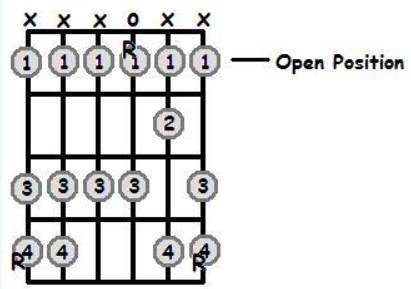
Position 3

Position 4
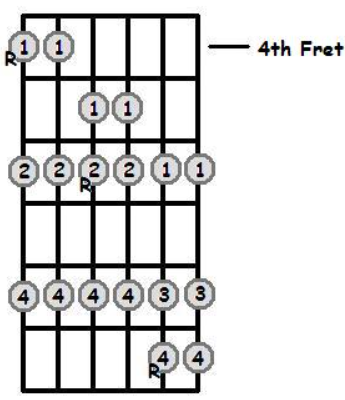
Position 8

Position 9

Remember, mastering a scale not only involves playing it up and down but also getting to know its sound, experimenting with its notes to create melodies, and understanding its application in songs and improvisation.
Practice Tips
- Start Slow and Increase Gradually: Begin by playing the A flat major scale very slowly to ensure accuracy in finger placement and note articulation. As you become more comfortable, gradually increase your speed. This approach helps in building muscle memory and improving your technique without sacrificing accuracy.
- Use a Metronome: Practicing with a metronome is essential for developing good timing and rhythm. Start with a slow tempo that allows you to play each note clearly, and as you improve, gradually increase the speed. This will also help you stay in time if you’re playing with others or along with music.
- Focus on Clean Transitions: Pay special attention to the transitions between notes. Ensure that your fingers are moving efficiently and that there’s minimal buzzing or muting of strings. Clean transitions will make the scale sound more fluid and pleasant.
- Practice in Different Positions: The A Flat Major Scale can be played in various positions on the fretboard. Once you’re comfortable in one position, try to learn and practice the scale in another position. This will not only improve your fretboard knowledge but also make you more versatile in your playing.
- Incorporate Different Techniques: As you become more familiar with the a flato major scale, try to incorporate different playing techniques such as hammer-ons, pull-offs, slides, and bends. This will not only make your practice more interesting but also enhance your expressiveness on the guitar.
- Practice with Musical Context: Practice the a flat major scale within the context of music. This could involve playing along with backing tracks, using the scale to improvise solos, or creating your own melodies and licks. Applying the scale musically will help reinforce your knowledge and make practice more enjoyable.
- Regular, Short Practice Sessions: Short, focused practice sessions are often more effective than infrequent, long sessions. Aim for regular practice, even if it’s just for a few minutes each day. Consistency is key to progress.
- Record Your Practice: Occasionally record yourself playing the a flat major scale. Listening back can help you identify areas that need improvement, such as uneven tempo, inaccurate notes, or unclear articulation.
- Relax Your Hands: Ensure that your hands and fingers are relaxed while playing. Tension can hinder your playing speed and cause unnecessary fatigue. Regular breaks during practice can help prevent strain.
- Set Goals: Set specific, achievable goals for each practice session, whether it’s to play the a flato major scale cleanly at a certain tempo, to master the scale in a new position, or to improvise a short solo using the scale. Having clear goals can keep your practice sessions focused and rewarding.
Interested in taking your guitar skills to the next level? Click the below and book a free lesson with us! We’re committed to helping you express yourself freely on the guitar without endless scales and theory. Happy playing!
Author: Daniel Powers Jr, the founder of Real Brave™, serves as the chief inspiration to thousands of students in the Real Brave music instruction program. He’s also the visionary behind PracticePad™, an online platform for live one-on-one online music lessons, lesson tracking, and scheduling. Beyond his entrepreneurial pursuits, Daniel leads a non-profit organization that provides formerly homeless children with access to music education, making a profound impact on their lives. His unwavering dedication to music, innovation, and education continues to inspire individuals to reach their fullest potential while creating positive change in communities. Follow Real Brave on all the socials:
youtube.com/@realbraveinc
twitter.com/realbraveinc
https://www.tiktok.com/@realbraveinc
instagram.com/realbraveaudio
facebook.com/realbraveinc
